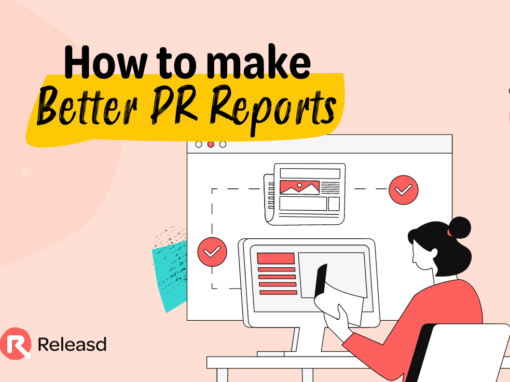If PRs cannot measure media coverage for their clients, how can they show the impact of their work? Demonstrating a clear return on investment (ROI) is crucial to proving the value of public relations and keeping clients happy. Releasd can play a pivotal role in elevating media coverage reports with integrated performance metrics – but we’ll come back to that later.
PR reporting traditionally involved providing printed-out clippings of articles featuring a client. While this may have been sufficient in the past, it is no longer enough to simply measure the volume of coverage. Fortunately, with the rise of digital media, PRs can provide clients with detailed analytics that offer insights into the overall quality and impact of the coverage.
“If you can’t measure it, you can’t manage it”. – Peter Drucker
PRs are now more equipped than ever before to communicate the value of their work to clients. With a treasure trove of data at their fingertips, there is no excuse for not providing detailed and insightful reports that paint a complete picture of their PR wins. PR software tools like Releasd can make this process even easier by streamlining the collection and presentation of data.
Sorry, there we go again. Releasd, Releasd, Releasd! We can’t resist name-dropping our public relations tool. After all, media coverage reports are our bread and butter. Before we explore how Releasd can help PRs create show-stopping media coverage reports, let’s take a step back and consider how media coverage reporting has evolved over the years. It’s been quite the journey!
How has media coverage analysis changed?
The volume of media coverage is no longer the primary metric by which PRs are judged. In the past, more focus was placed on the number of articles featuring a client rather than the quality of that coverage. Nowadays, clients are far more interested in seeing detailed reports that provide insights into the quality and impact of the coverage – with quantitative and qualitative data.
What is Advertising Value Equivalency (AVE)?
Traditionally, Advertising Value Equivalency (AVE) was the primary metric used to measure the value of media coverage. AVE is calculated by measuring the size of an article compared directly against the cost of a paid advertisement. This metric fails to account for the quality of the coverage, or whether the article presents the client in a positive or negative light.
Are PR agencies still using AVE?
Nowadays, PRs are moving away from AVE and towards more sophisticated metrics that offer a true measure of the quality and impact of media coverage. Surface-level metrics no longer cut it. Based on the data included in our KPI report, 6% of media coverage reports created in 2021 included AVE. So, why are some PR agencies reluctant to move away from this metric?
We feel the continued use of AVE shows that PR agencies lack the resources to collect quantitative and qualitative data on the media coverage they generate for their clients. AVE is well past its sell-by date, and PR agencies need to evolve their reporting if they want to inspire confidence and improve client retention. This is where modern, next generations media coverage reports come in.
What is included in a media coverage report?
Producing a media coverage report is about more than just pulling together a PDF full of press clippings. A good media coverage report will provide detailed insights into the quality and impact of the coverage, as well as offer a glimpse into future opportunities. With no shortage of metrics at their disposal, PRs can showcase the value of their work like never before.
Is the client leading the conversation around a particular topic? PRs can leverage media monitoring tools to calculate the value of the client’s brand perception. PRs can ascertain the influence a client has in their industry compared to their competitors. Measuring share of voice will enable PRs to understand whether their clients are leading conversations in their industries.
Brand and industry mentions
Are people in the client’s industry talking about them? PR professionals can track brand and industry mentions using media monitoring tools to see how often the client is being mentioned compared to others in the industry. Media monitoring is critical as it allows PRs to track the impact of their work, as well as identify positive and negative sentiments.
Website traffic statistics
PRs can use coverage reporting tools like Releasd to collect website performance data. With integrated data on monthly visits from Similarweb, Releasd enables PRs to add website traffic statistics to their coverage reports. Measuring website traffic is an example of how PRs can go a step further than providing a list of article links, but there is an even more powerful metric that can be exploited…
Coverage Views
How many times has the coverage been seen? Views give PR professionals a more potent way to quantify the success of their work. Releasd’s coverage reporting tool enables PRs to seamlessly track coverage views and present this data in an intuitive format to clients.
Sentiment analysis
What was the sentiment of the coverage? Was it positive, negative or neutral? Sentiment analysis provides clients with useful insights into how the coverage is perceived and how it might impact their reputation.
Audience analysis
When PRs have a clear understanding of who the coverage is reaching and whether it is resonating with this audience, they can present these findings to clients and offer a data-backed strategy on how to proceed.
In closing
Well-executed media coverage reports enable PRs to communicate value creation. These reports create an opportunity for PRs to present their hard-won coverage. As we have explored, agencies can leverage a range of different metrics to highlight their overall performance and paint their work in the best possible light.
When PRs have fought long and hard for coverage, the last thing they want to do is present it in a way that doesn’t demonstrate impact. With Releasd, PRs can be sure that their reports will make a lasting impression on clients. This PR analytics software enables PRs to include all the key metrics that clients look for, as well as go above and beyond with integrated data.
To learn more about how to create media coverage reports with Releasd, contact us today to get started.



